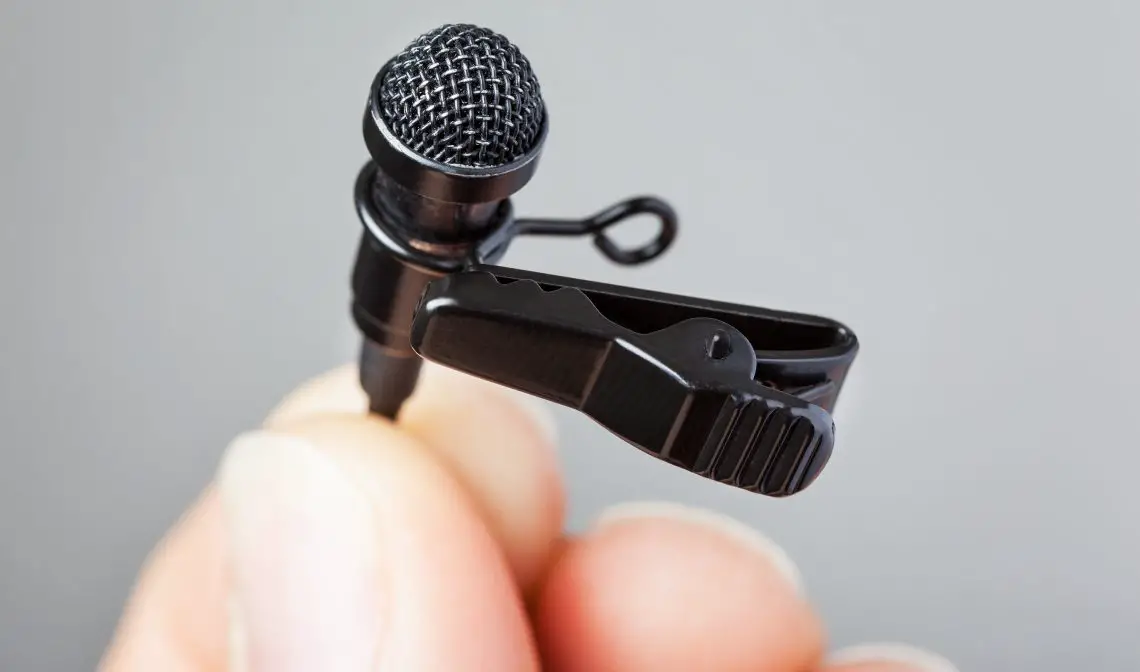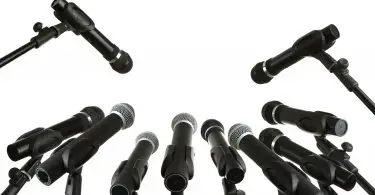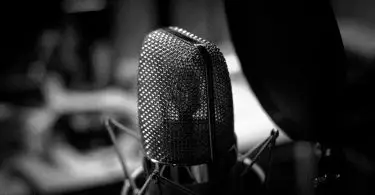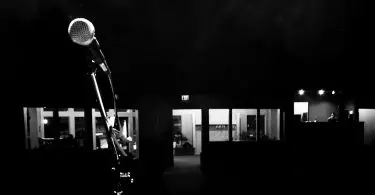Video professionals have long used lavalier mics as a means of capturing sound. Still, they have only recently begun to be a viable option for musicians, thanks to advances in dynamic sound quality.
As a film and video professional, I have spent years working with a great range of sound equipment – sometimes on my own and sometimes with a sound engineer or professional sound recordist.
What is desirable in a lav mic for video recording differs greatly from what is desirable for music recording. Lavs with a high dynamic range have also been on the market for some time, but their price tag was often prohibitively expensive for amateur musicians or local acts.
With technological advances, prices are decreasing while quality is increasing, making lavs a legitimate choice for even amateur musicians or smaller or local professional acts.
Inexpensive lav mics have traditionally been great for recording speaking voices because the spoken word only produces a very limited range of sound, not to mention very narrow criteria for what is and is not desired in the final recording.
Music produces a far more complex variety of sounds that falls into a far broader spectrum. From full, rich bass to shrill high notes to the softest whisper of sound, musicians place far greater demands on a mic than speakers do.
Between my experiences, testing, recommendations from the film world, and the music world in regard to wired mics, I’ve been able to compile a list of lav mics that meet the very specific demands of musicians.
The ClipMic offers a wide range of features that make it a clear winner based on a combination of price, performance, and ease of use. Simply connect the ClipMic to the Lightning port on your iOS device and you are ready to begin recording.
Allows for a far wider range of uses than simply charging a phone; one of which was for better data transfer.
Coming up with the #1 choice involves weighing many factors, which means our #1 choice is based on criteria that may not apply to you.
-
 Check on Amazon
Check on AmazonThe ClipMic offers a wide range of features that make it a clear winner based on a combination of price, performance, and ease of use. Simply connect the ClipMic to the Lightning port on your iOS device and you are ready to begin recording.
-
 $129.95Check on Amazon
$129.95Check on AmazonAllows for a far wider range of uses than simply charging a phone; one of which was for better data transfer.
06/29/2025 04:08 am GMT -
 $69.00Check on Amazon
$69.00Check on AmazonPlug and play compatibility with most smart phones and tablets, a free app that allows you to make a number of adjustments.
06/29/2025 01:18 am GMT -
 $29.00Check on Amazon
$29.00Check on AmazonCan help cut down on wind noise, making it suitable for outdoor use.
06/29/2025 01:03 pm GMT -
 $159.00Check on Amazon
$159.00Check on AmazonThis cardioid condenser features a switchable low-frequency roll-off, which makes it excellent for vocals and acoustic guitars
06/29/2025 01:24 am GMT -
-
 $1,099.00Check on Amazon
$1,099.00Check on AmazonThis Portable Wireless Microphone System & lav offers the highest levels of sound quality and dynamic range, it also requires a full system to operate,
06/29/2025 03:05 am GMT -
 $14.95Check on Amazon
$14.95Check on AmazonThis 2.4GHz Wireless Lavalier Microphone System has an integrated 164-foot range antenna. The receiver headphone also features a second isolated microphone to allow communication with the transmitter headphone.
06/29/2025 03:09 am GMT
Here is a complete run-down on what factors go into choosing the best lav mic and how to decide for yourself which is the right mic for your needs..
How To Choose The Right Lav Mic For You
While we can choose a #1 mic based on a compilation of many factors, the reality is the best overall lav mic might not be the right one for you. Here are some factors that I considered when making my choice, that may lead you to decide a different lav is right for you.
1. What environment are you using it in?
Lav performance highly depends on what kind of environment it’s being used in. The best mic for recording a live outdoor performance might differ from the best for recording a live indoor performance, which will be different from the right lav for studio recording or simply recording in a quiet space.
Your choice may depend on where you perform or use it most often. Lavs can run anywhere from $20 to several hundred dollars, however, so it’s not out of the question to have a few different mics that perform differently under different circumstances.
It might also be that you want to have one very expensive lav that you use when performing at indoor paid gigs and another much less expensive one that you use for any outdoor performances or if you do any “busking.”
Also, keep in mind, many lavs are only designed for recording sound, not broadcasting sound. Some lavs don’t even have the ability to be used for broadcasting sound.
2. What kind of sound do you want your mic to produce?
Like wired mics, different types of lavs produce different sounds. Here is a video using wired mics that show the different type of sounds that different types of mics produce.
While this article is older and the lavs recommended are outdated, it provides a great deal of helpful information about how lavs work and how to choose the kind of lav that is right for you.
Again, this article is aimed more at using lavs for video sound, but many of the same principles still apply. One of the links in this article leads to another article for shooting “location sound.”
The first part of that article is very video specific, but the second part of the article (starting with the “chain” of sound recording) gives some great information for musicians that may not yet have the budget to hire a full-time sound person.
3. What is your price range?
How much you want to spend on a lav will be largely determined by how often you use it and how much additional equipment it requires. Some lavs run only a few hundred dollars or less and work with a smartphone or tablet.
Other lavs can run hundreds of dollars and require several thousands of dollars of additional equipment, such as separate receivers, a mixer, and a digital recorder.
I chose the #1 option because it offers great dynamic, sound while still offering plug and play compatibility at a very reasonable price (around $200). And works with an Apple watch, which means you can make your own adjustments while on stage or can start and stop recording easily.
The additional benefit of this is that it provides the best of both worlds: a wired mic (which provides infinite better sound quality than a wireless mic) that can be plugged into a phone in your back pocket, which means you don’t have a bunch of cables and cords to tape down or trip over.
4. How many inputs do you need?
The #1 recommendation offers a prime feature that most “plug and play” lavs do not: the ability to record up to four sources at once on a single device.
If you need numerous inputs and the ability to do more rigorous mixing, you will most likely have to invest in a full system, which can run several thousands of dollars.
5. Weigh the Pros and Cons
If you are a national touring act, then you have a much larger budget to work with. This list, however, was compiled based on the premise that there are far more smaller or local acts,, so most of the lavs represented here are for smaller bands, local acts, and amateur musicians.
When you have a budget to invest in several thousands of dollars of equipment, you also can most likely hire a sound engineer, who will have their own recommendations in regards to sound equipment like lavs and other mics.
Here are some of the pros and cons of using lav mics versus traditional stand mics.
Pros
- The entire system can fit in your pocket. No more lugging mic stands and struggling with numerous cables and cords to string a whole system together
- Quick and easy setup. Just a few minutes and you can be ready to go
- Major technological advancements produce better and better sound quality
- Ability to record on a small, portable device that you probably already own, like a cell phone, tablet or notebook computer
- Great for a “one man show” or solo gig: eliminates a great deal of large, bulky equipment and gives you total control right where you are
Cons
- If you are not a “one man show” you need a lav AND a recording device for each individual or a full, high-end system for recording
- Recording sound from multiple sources can still prevent a number of challenges
- Even the best lavs still don’t have the same ability to capture the full, dynamic range of sound that larger, wired mics do
- Lav mics are highly susceptible to cracks and pops from clothing movement, etc.
With all of that in mind, here is my top pick for the best lav for musicians, as well as several of the runner-ups.
Our Top Pick:
Apogee Sennheiser ClipMic for iOS Devices
The ClipMic offers a wide range of features that make it a clear winner based on a combination of price, performance, and ease of use. Simply connect the ClipMic to the Lightning port on your iOS device and you are ready to begin recording.
Coming in at a great value, the Apogee Sennheiser ClipMic Digital Mobile Recording Microphone offers the dynamic recording range of higher-end lavs with the ease of a plug and play device.

Credit: Sennheiser electronic GmbH & Co.
It also offers a wide range of features that make it a clear winner based on a combination of price, performance, and ease of use.
Plug and play compatibility: You don’t need a degree in audio engineering to figure out how to set it up. Simply connect the ClipMic to the Lightning port on your iOS device and you are ready to begin recording.
The ClipMic for iPhone is a simple product that can be used in a variety of situations. It includes a digital interface that plugs into the iPhone’s lightning port and an analog to digital converter. The package includes a metal alligator clip to attach the mic to clothing and a small metal pop screen to protect the mic diaphragm.
The mic is omnidirectional, which provides more flexibility in how it is attached or hidden in clothing. The audio quality is good for this style of microphone. The mic is a solid solution as a standalone mic and recorder combo for single-channel audio feed.
On the downside, however, the cable is short, and the Lightning connector doesn’t allow for charging while in use.
Sennheiser Pro Audio ME 2-II
Allows for a far wider range of uses than simply charging a phone; one of which was for better data transfer.
The Sennheiser ME 2 omnidirectional lavalier EW microphone is a powerhouse on its own, but the Apogee Sennheiser ClipMic combines Sennheiser quality with Apogee technology for the best digital capture.
 Credit: Sennheiser electronic GmbH & Co
Credit: Sennheiser electronic GmbH & Co
Sennheiser has long been a dominant leader in the sound recording industry with a long-established reputation for creating stellar products that capture crisp, clean, dynamic sound. The omnidirectional capsule in the Sennheiser ME 2 delivers superb clarity and speech intelligibility.
Digital Signal Conversion
The great digital sound is dependent not just on the quality of the microphone itself, but also on how the signal is eventually digitized.
This is where Apogee comes in. Sennheiser created a state-of-the-art microphone, while Apogee created the external converter that digitizes the same clean, crisp, dynamic sound that the Sennheiser ME 2 picks up, resulting in high-resolution data and clean, crisp, digital sound.
Lightning Connector
For musicians that use PC/Android products, this may not seem like much of a perk, but Apple originally designed the lightning connector to allow for a far wider range of uses than simply charging a phone; one of which was for better data transfer.
When it comes to digital recording, better data transfer results in far superior digital recording. This means recording via a lighting connector offers a far greater data transfer rate than recording than recording via the 3.5 mm jack that most “plug and play” lavs use.
Using the lightning connector allows for recording in resolutions of up to 24-bit, 96kHz in WAV or CAF formats.
When considering a lav for musical use, think of it this way: your speaking voice is like a Word document: it doesn’t contain a lot of “data” to record, which results in very small files which mean they still transfer very quickly even over the slow connection.
Music, however, is more like a video file: it contains far more “data,” which requires a much faster data transfer rate. A lightning connector offers a far superior means of transferring data, which result in a superior digital recording.
The best means of recording sound will always be an XLR cable, but XLR cables also require expensive recording systems, which also require a great deal of time and energy to set up. The lighting cable falls somewhere between the capability of a 3.5 MM jack and an XLR cable.
While this means an additional expenditure for musicians that don’t currently own or use an iOS device, lightning connectors are available on iPods going back a few generations. You can pick up an older iPod fairly cheaply and will get a far better digital recording as a result.
This is also helpful for users of the iPhone 7, which no longer has a 3.5 mm jack available for use.
Apogee MetaRecorder App
This free app is an extremely flexible two-channel audio recording app for iOS devices that allows you to make simple adjustments like mic levels and more advanced adjustments like hardware input, gain and DSP.
The app also allows you to activate a Rumble Reducer, Hiss Reducer, and Overload Eliminator making recording, tagging and organizing audio files simple and efficient. While you can always record directly into a program like ProTools or Garage Band, doing so generally requires recording into a laptop or desktop computer.
An app allows you to record directly to a portable iOS device and still have a great deal of control over setting a wide variety of levels, which you can later tweak even further in a desktop application.
The Master-Satellite Link feature also makes it possible to link one Master iOS device via Wi-Fi to up to 3 Satellite iOS devices. Once the link is established, every action you perform on the Master is duplicated on the Satellites.
This allows you to use one device to initiate recording and playback, set input levels, and even monitor the Satellites’ audio recording and playback. Since each Satellite also records its own audio, this also offers the best of both worlds: the convenience and flexibility of a wireless system and the reliability of standalone internal recording.
If you don’t like the mix you get from all four channels together, you have stand-alone recordings you can go back and remix later.
***NOTE: The MetaRecorder app is a free app, but the free version only allows you to record up to 60s of audio. As of this writing, if you plug a compatible Apogee device into your iOS device, it unlocks the full version for free, which allows you to record full-length songs.
The Master Satellite Link, however, that allows you to record from multiple devices is a paid feature above and beyond purchasing or unlocking the “full” version of the app.
Apple Watch Compatibility
Simple tasks such as starting and stopping a recording, marking recordings and adjusting peak and gain can all be accomplished via your Apple Watch, making it even simpler and easier than ever to be a one-man (or woman) show.
Ultimately, the Apogee Sennheiser ClipMic is not necessarily the very best mic on the market, but when choosing a mic that will cover the varying needs of a wide range of musicians, this mic offers a number of features and high quality at a very reasonable price point.
There are obviously a lot better lav mics available at a much higher price point – and many available at a lower price point, but for an all around blend of perks and features, this is far and away the best all-around lav mic/ system available.
Runner Up:
Rode smartLav+ Lavalier Condenser for Smartphones
Plug and play compatibility with most smart phones and tablets, a free app that allows you to make a number of adjustments.
It comes in at a significantly lower price point and offers many of the same key features of the Sennheiser: plug and play compatibility with most smartphones and tablets, a free app that allows you to make a number of adjustments.

Credit: RØDE Microphones
This mic was the runner-up for one key reason: like most “plug and play” lavs that record on phones or tablets, it uses a 3.5 mm jack for recording, rather than the superior lightning connector.
While it comes with a foam pop shield, (which softens vocal plosives and wind noise) which might make it a better choice for outdoor use, overall the Sennheiser ClipMic offers far superior performance all around.
The Rode smartLav+ only allows for recording from two lavs, via an input adaptor which is sold separately. If you don’t feel you will ever need to record from more than two lavs at once, then the Rode smartLav+ may be a better choice for you.
Honorable Mentions:
For all-around quality, convenience, ease and price point, these two lavs are considered far and away to be the best options, but they are by far not the only options.
“Plug and Play” lavs are widely available, and many come with significantly lower price tags, but its important to keep in mind that they are usually designed for optimal recording of speaking voices, not music.
If you just want a decent lav that records audio relatively well, here are some lower priced options as well as some higher priced options that require more professional equipment to use them with.
Audio-Technica ATR3350xiS Omnidirectional Condenser Lavalier
Can help cut down on wind noise, making it suitable for outdoor use.
If you just want a basic, full-featured lav mic with no specially designed apps, which provides plug and play functionality with a minimal price tag, then the Audio-Technica ATR3350xiS is probably right for you.
Coming in at around lower price than most, it features a windscreen like the Rode SmartLav+, which can help cut down on wind noise, making it suitable for outdoor use. One drawback to the ATR3350xiS, however, is that it doesn’t run on phantom power, but instead requires a single LR44 battery.
Batteries can sometimes be unreliable and even putting a fresh battery in before every use does not always guarantee it will work for as long as you need or want it to.
Audio-Technica PRO 70 Cardioid Condenser
This cardioid condenser features a switchable low-frequency roll-off, which makes it excellent for vocals and acoustic guitars
The Audio-Technica PRO 70 is considered to be a semi-pro level lav mic. It is considered to be one of the best lavs available for musicians with a switchable low-frequency roll-off for vocals and acoustic guitars.

Credit: Audio-Technica U.S., Inc
It can also run on either phantom power or off an available battery pack (sold separately.) It comes with an Integral 6′(1.8 m) cable that is permanently attached between the microphone and power module, so this is neither a wireless system nor can it be used to record to a smartphone or tablet.
This lav must be used with a full recording system. It utilizes a cardioid polar pattern which reduces the pickup of sounds from the sides and rear and improves the isolation of the desired sound source.
Overall, this is a relatively professional level lav at a reasonable price.
Pyle-Pro PDWM96
Offers an operation range of up to 60 feet.
If you absolutely, positively need a wireless system but don’t have the budget for one, the Pyle-Pro PDWM96 Wireless Lav system might be what you are looking for.

Credit: Pyle Audio
An inexpensive option, it offers a body pack Transmitter with a clip-on mic and a receiver with 1/4” plug. Obviously, for less than $20, don’t expect a lot of bells and whistles – or any controls other than a volume control.
It does offer an operation range of up to 60 feet, however, so that’s a perk. The belt pack transmitter requires a 9V battery, and the wireless transmitter uses a single AA battery.
Just keep in mind, however, that at this price point sound quality is not going to be high. And to use this system with a cell phone or tablet, you may have to buy an adaptor, which may or may not work properly.
If you check the comments section on the Amazon listing, one user found an adaptor which they say actually did the trick – after trying a number of adaptors that did not.
Sennheiser EW 100 ENG G4-A
This Portable Wireless Microphone System & lav offers the highest levels of sound quality and dynamic range, it also requires a full system to operate,
On the other end of the price spectrum is the Sennheiser EW 100 ENG G3-A, at the professional level. The Sennheiser EW 100 ENG G4-A is a wireless lav system and comes with a transmitter, receiver and wireless lav.
One thing to keep in mind about a system like this is that it requires you to be sure you are transmitting on an available frequency and not on an emergency or reserved channel, which can land you in a lot of hot water.
While this lav offers the highest levels of sound quality and dynamic range, it also requires a full system to operate, which (again) can run you several thousands of dollars.
This is probably not a good option for a “do-it-yourself” musician but is probably best placed in the hands of a professional audio engineer. If you have the cash and need a truly high-end wireless recording system, this is one of the very best available.
Movo WMIC50 Wireless Lavalier Microphone System
This 2.4GHz Wireless Lavalier Microphone System has an integrated 164-foot range antenna. The receiver headphone also features a second isolated microphone to allow communication with the transmitter headphone.
Coming down roughly in the middle of the Pyle-Pro PDWM96 price point and the Sennheiser EW 100 ENG G3-A is the Movo WMIC50 wireless system.

Credit: Movo
The 2.4GHz system features internal boost antennas, which give it an impressive 164-foot (50-meter) range. It includes a transmitter with belt clip, a receiver with a camera shoe or tripod mount and a Lav with two earphones.
The receiver headphone also features a second isolated microphone to allow communication with the transmitter headphone. Headphone jacks on both the transmitter and receiver also allow you to monitor sound on either end.
Both the transmitter and receiver require two AAA batteries which purportedly gives you 3.5 to 4 hours of runtime we only got around 3 hours.
The type of battery used may have something to do with this, and Lithium batteries may extend the operating span even beyond the 4-hour mark.
Audio input/ output is via a 3.5 MM jack, which is – once again – not the most optimal for music recording.
The WMIC50 offers higher quality and more features than the Pyle-Pro PDWM96, without the hefty price tag of the Sennheiser EW 100.
To recap, here’s the full competition:
The ClipMic offers a wide range of features that make it a clear winner based on a combination of price, performance, and ease of use. Simply connect the ClipMic to the Lightning port on your iOS device and you are ready to begin recording.
Allows for a far wider range of uses than simply charging a phone; one of which was for better data transfer.
Plug and play compatibility with most smart phones and tablets, a free app that allows you to make a number of adjustments.
Can help cut down on wind noise, making it suitable for outdoor use.
This cardioid condenser features a switchable low-frequency roll-off, which makes it excellent for vocals and acoustic guitars
Offers an operation range of up to 60 feet.
This Portable Wireless Microphone System & lav offers the highest levels of sound quality and dynamic range, it also requires a full system to operate,
This 2.4GHz Wireless Lavalier Microphone System has an integrated 164-foot range antenna. The receiver headphone also features a second isolated microphone to allow communication with the transmitter headphone.










Start the discussion at talk.hearthemusicplay.com